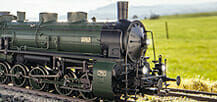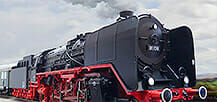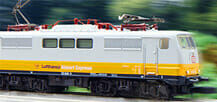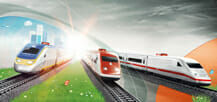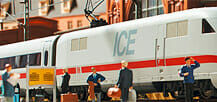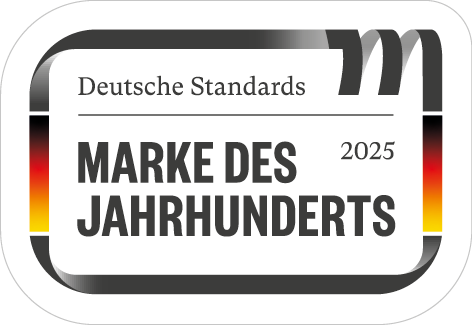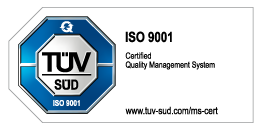Rail Bus with a Trailer Car
Prototype: German Federal Railroad (DB) class VT 95.9 powered rail bus with a class VB 140 trailer car. First production series, in the original crimson paint scheme, with a skylight window above the engineer's stand. The rail bus looks as it did when delivered and in operation around 1952/53.
Most Important Facts
| Article No. | 39950 |
|---|---|
| Gauge / Design type | H0 / 1:87 |
| Era | III |
| Kind | Powered Rail Cars |
Check with your local dealer Find Dealer
Highlights
- Completely new tooling.
- Extensive operating and sound functions included.
- Factory-installed interior lighting.
- Headlights on the motor car can be turned off separately in digital operation.
- Red marker lights on for the trailer car depending on the position of the motor car.
- Lighting with warm white and red LEDs.
-
Product description
Model: The rail bus has an mfx decoder and extensive sound functions. It also has controlled high-efficiency propulsion with a flywheel in the motor car. 2 axles powered. Traction tires. The rail bus has factory-installed interior lighting in the motor car and the trailer car. The rail bus has dual headlights and dual red marker lights that change over with the direction of travel, will work in conventional operation, and can be controlled digitally. The headlights at the Engineer's Stand 2 and 1 of the motor car can be turned off separately. Dual red marker lights are on for the trailer car depending on the position of the motor car. Maintenance-free warm white and red LEDs are used for the headlights, marker lights, and interior lighting, and they can be controlled together in digital operation. The rail bus units have a current-conducting drawbar coupling with a guide mechanism between them. An additional non-current-conducting drawbar coupling is included for use in multiple hookups of rail bus sets. When you have a maximum 4-part unit (2 double units), the red marker lights on the trailer car can be turned off by means of a switch. The engineer's stands and the cars' interiors in the motor car and trailer car allow an open view through the windows. Brake hoses are included and can be mounted on the rail buses.
Length of the two-unit set 28.2 cm / 11-1/8".This model can be found in a DC version in the Trix H0 assortment under item number 22995.
Find more Märklin explanation videos on our YouTube Channel
Spare parts for our articles can be found here in our spare parts search.
-
Publications
- New items brochure 2014 - Product programme 2014/2015 - Product programme 2015/2016
-
Prototype information
VT 95.9 with the VB 142 (Rail Bus and Trailer Car) The first rail buses arose from the desire as early as the Thirties to develop lightweight, modest vehicles that made use of parts and assemblies from trucks and street buses. Soon after the end of World War II, the German Federal Railroad recognized that operations on many uneconomical branch lines could be maintained against the growing competition on the roads only through the extensive use of such rail buses. In 1949, the car builder Uerdingen was therefore awarded the contract to develop such a vehicle. Eleven prototypes were placed into operation between March and August of 1950. The similarity to street buses was unmistakable. A wheelbase of 4,500 mm / 14 feet 9 inches, lightweight shock absorbers, as well as a truck trailer coupling were characteristic features. A Büssing motor with 110 horsepower output connected to a mechanical six-speed transmission mounted below the floor provided the drive system to one wheel set. Road number VT 95 912 (later VT 95 9112) came in November of 1950 and was the last, above all groundbreaking pre-production unit. Special permission from the transport minister allowed the wheelbase on this rail bus to be lengthened to 6,000 mm / 19 feet 8 inches. Sufficient seating room was now available thanks to the lengthening of the car body. After exhaustive testing an entire family of rail buses came into being in the Fifties. A first series of 60 units of the single-motor VT 95 rolled out from the builders starting in 1952. The fixed wheelbase of 6,000 mm / 19 feet 8 inches remained but otherwise there several changes. The ends were now ellipsoidal in shape and were equipped with curved skylight windows. The skylight windows were done away with on later series. Three-part folding doors on the car ends allowed passengers to get on and off quickly. The short wheelbase of 4,500 mm / 14 feet 9 inches was kept on the accompanying trailer car, the class VB 140 (not designated as the class VB 142 until the end of 1953), but their shape was adapted to that of the motor cars. Lightweight Scharfenberg couplers now transferred the tractive and impact forces. Sprung shock absorber bales served elastically to absorb gentle contact with normal buffers. By 1955 five additional series with a total of 496 rail buses followed the first one, whereby the performance was continuously increased with the installation of 130 and later 150 horsepower motors. The DB finally replaced steam locomotives on numerous branch lines with these units, because operations on many lines could only be maintained at all with the extremely economical operation of the rail buses. The single-motor rail buses (from 1968 on the class 795) were retired in large numbers starting in the mid-Seventies. The last one, road number 795 445, was pulled from service in 1983. Numerous 795 rail buses found a new lease on life in other countries and in Germany on museum railroads of course. Road number 795 240 (former VT 95 9240) belongs to the DB's museum roster.
-
Digital Functions
Control Unit Mobile Station Mobile Station 2 Central Station 1/2 Central Station 3/2*
Mobile Station 2**Headlight(s) Diesel locomotive op. sounds Horn Direct control Sound of squealing brakes off Headlight(s): Cab2 End Conductor's Whistle Headlight(s): Cab1 End Doors Closing * New features of the Central Station 2 (Part No. 60213, 60214 or 60215) with the software update 4.2
** New features of the Mobile Station 2 (Part No. 60657/66955) with the Software Update 3.55
